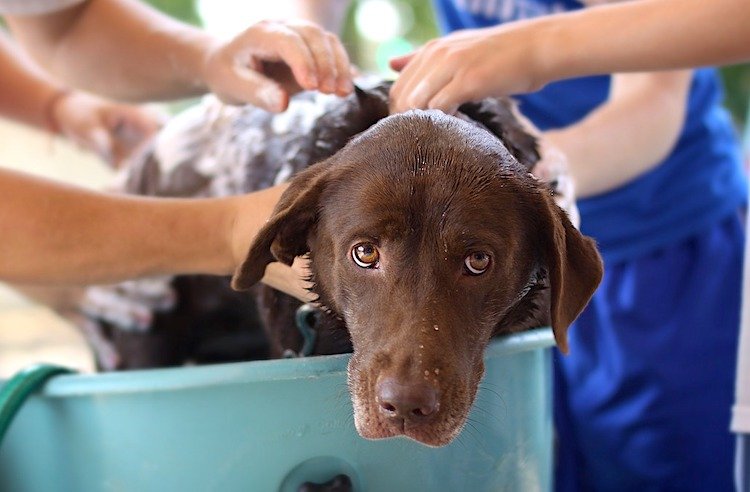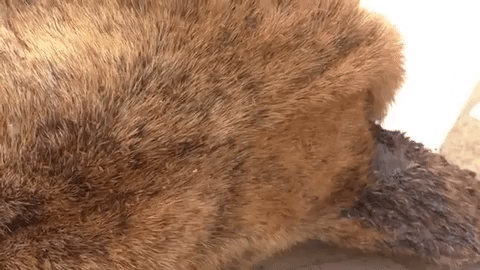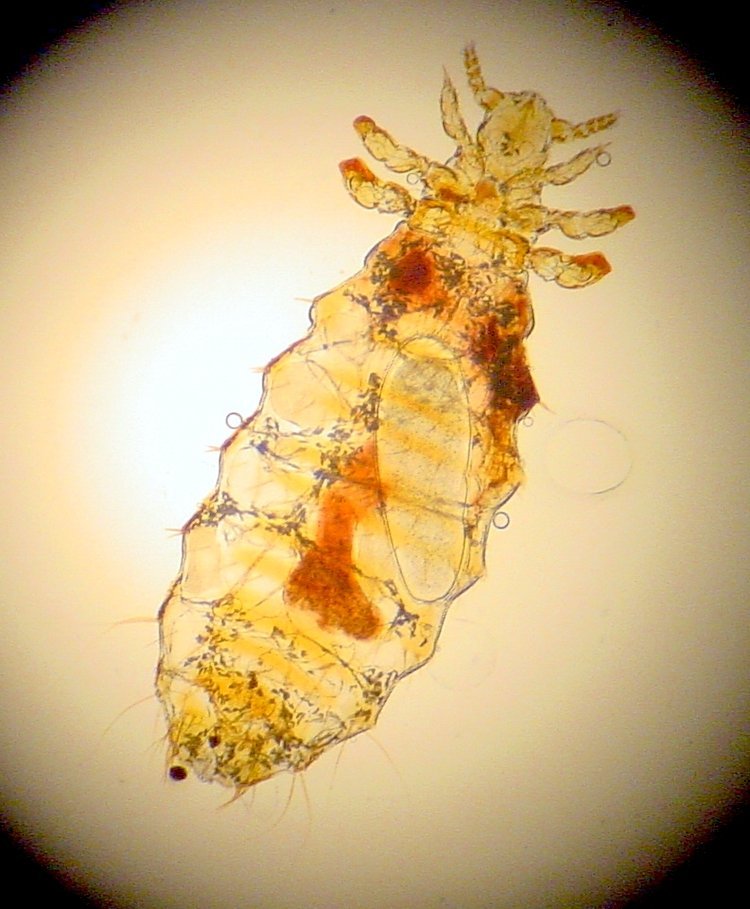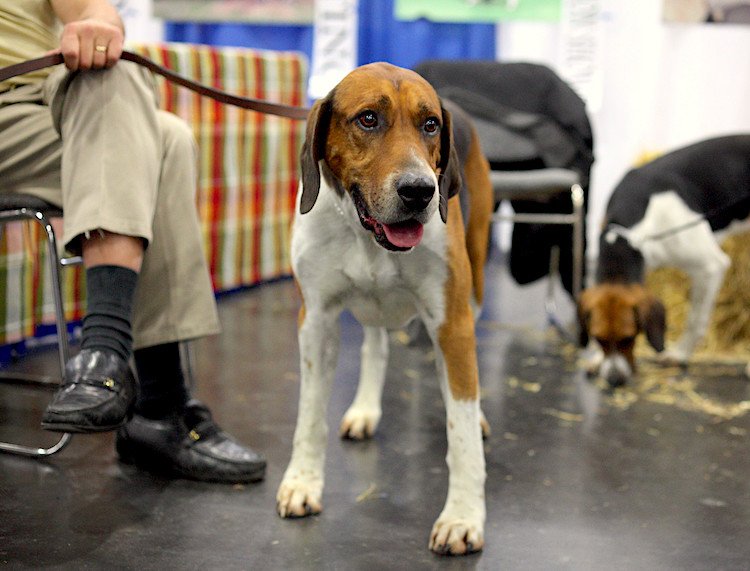Can Dog Lice Live on Humans?
Some diseases can be transmitted from animals to humans — but lice is not one of them.

I just did a quick online search about dog lice and found a bunch of people who think their pets are transmitting all kinds of diseases, like lice, to them or their kids.
There are serious zoonotic diseases out there — diseases that can be transmitted from animals or insects to humans. But lice is not one of them.
Since head lice became such a resurgent problem in children over the last 40 years or so, people got crazy about a supposed link to pets and kids. Your dog did not transmit lice to your kids. Dog lice do not live on humans.
My twins had head lice in 1989 in rural Massachusetts. They contracted them again at another local school district in 1994. Disgusting. Upsetting.
I used the correct products. I looked like a chimpanzee nitpicking through their little heads and going crazy until we got over it.
If you have young children, usually ages 3 to 11, diagnosed with head lice, you will get through it! The lice did not come from your dog or cat.


Don’t leave your pet’s food safety to chance
Sign up for Petful recall alerts today.

Questions and Answers About Dog Lice
Can dog lice live on humans?
No. Dog lice do not live on humans.
My kid came home from school with lice — is my dog the source?
No. This would be highly unlikely. Although a dog louse can get on a human, it cannot live on us. It dies.
Is dog lice common?
No. As Guilie Castillo Oriard writes in her book It’s About the Dog, “It’s actually rather rare for a family dog to get lice; many dog owners don’t even know that do lice exist. That’s because they thrive in extremely unsanitary conditions (think garbage dumps).”
How can you diagnose lice on a dog?
Go to your veterinarian.
Lice Are Species Specific
The good news is that lice can’t be transmitted from one species to another. Dog lice stay on dogs, cat lice on cats, human lice on humans.
As mentioned earlier, it is possible that a dog louse can get on a human — but it can’t live on us. It dies. This is a grand plan of nature!
If you or your child have a lice infestation that is not going away, it’s a human lice problem, not a dog lice problem.
This goes the other way, too: Your dog can’t get your kid’s lice. Human lice won’t survive on a dog.

What Are Lice?
Lice are flat, 6-legged wingless insects that can be seen with the naked eye.
They live their entire life on your pet. They lay eggs, called nits — those nasty white things on the shaft of hair.
You probably have never seen lice on your dog, but you may have had a child, like me, sent home from elementary school with lice. Those nits are easy to see on your kid’s head.
Although lice are gross, upsetting, disgusting, however you want to express it, we can effectively treat them on any living creature, human or dog.
Dogs get 2 main forms of lice:
- Trichodectes canis is a chewing louse. Found throughout the world, Trichodectes is a vector for the canine tapeworm. When you find tapeworms on your dog, usually dried, rice-shaped segments around the anus, the most common cause is a flea problem (although lice should be considered).
- Linognathus setosus is the sucking louse. This icky parasite sucks your pup’s blood through the skin. Linognathus can cause more skin damage than Trichodectes and can actually cause anemia, particularly in a puppy. This louse is also found throughout the world and is a bit hardier, liking longhaired dog breeds and able to withstand colder climates.
How Did My Dog Get Lice?
Your dog can get lice only from another dog with lice or from nit-contaminated bedding, grooming equipment, etc. Lice do not live long in a clean environment.
Lice are not common in the United States or Europe. Due to climate change and the nasty way parasites can reinvent themselves, however, they are beginning to adapt to drier, cooler environments.
Lice infestations most commonly occur in tropical areas. Rural Central and South America, Africa, and the Middle East report infestations of 4–22%. Since reporting in these areas is not always reliable, the incidence of lice could be much higher.
If you adopt a dog from a very warm climate or from a dense shelter with poor husbandry, lice are a possibility.
Symptoms of Lice on Your Dog
As with most ectoparasites (parasites that live on the skin), your dog will exhibit itching with lice. As the infestation gets worse, you might see a scruffy coat and bald patches.
Look for any of the following symptoms of dog lice:
- Itching, scratching or biting
- Dry, poor-quality coat
- Matted fur
- Hair loss
- Restlessness (because your dog is itchy)
- Anemia and/or unthrifty puppies with severe infestations
Distribution of lesions on your dog help with a diagnosis. Lice love to live around the ears, neck, shoulders and anus.
Since so many different skin diseases and parasites can cause similar symptoms like itching and scratching, observing where the lesions occur helps your vet narrow down the cause.
How Do You Diagnose Dog Lice?
- Carefully examining the skin can reveal lice. A magnifying glass helps.
- A flea comb can help to identify lice on the skin.
- Your vet might simply place some acetate tape to the dog’s fur and look for adult lice or nits under a microscope if lice have not yet been identified.
- A simple, painless procedure called a skin scrape is a basic part of any dermatologic (skin) exam. Your vet will most likely want to do this to make sure your pet doesn’t have other, more common ectoparasites like Demodex or Sarcoptes mites (commonly called mange).

Treatment of Dog Lice
Because lice are rare, they have not developed much resistance to our common insecticides. This is a good thing.
- Bathing your dog with an insecticide (flea and tick shampoo) should eliminate adult lice. Follow this with a spray or powder.
- To eradicate all other stages of the lice, use a flea/tick product such as Revolution or Frontline every 1–2 weeks for several treatments. This should be done with help and guidance from your vet.
- Environmental control may be needed in rare cases with intense infestations. Clean all bedding or dispose of any bedding that cannot be washed.
- In longhaired dogs or dogs with severe matting, shaving the dog may help.
Diagnosis Is Important
Small animal veterinarians see an abundance of dermatology cases. Your dog is susceptible to fleas, mites, other ectoparasites, skin allergies and skin infections, just to name a few skin diseases.
All, repeat all of these skin diseases only get worse until they are diagnosed and treated. Trying to treat your dog yourself without a diagnosis from your vet may mean you are using the wrong product and allowing the skin problem to fester and become worse.
Lice are rare. If your dog is exhibiting scratching, itching, biting, hair loss or skin sores, chances are that simply buying a flea shampoo online is not going to solve the problem. Please seek a diagnosis.
Look at it this way: Have you ever had an itching problem? Poison ivy? Psoriasis? Severe reactions to insect bites? Unknown itchy rash? Itching can drive you crazy. It can make you cry. It can make you go to urgent care or the emergency room!
When I see a dog finally brought to me that has been itching for weeks to months and has big areas of hair loss and lesions on the body due to severe itching, it breaks my heart. These pups are suffering. They need the right diagnosis and treatment.
Veterinarians get intense training about zoonotic diseases. We are charged with not only protecting your pets, but also protecting you from anything you can get from your pet. We take zoonotic diseases very seriously, and we are there to help you and answer any questions you might have about what your dog might have given your kid.
Just call and ask.
References
- Lundgren, Becky, DVM. “Lice in Dogs and Cats.” Veterinary Information Network. https://www.veterinarypartner.com/Content.plx?P=A&C=15&A=2794&S=0&EVetID=900000117.
- Rothrock, Kathy. “Pediculosis.” Veterinary Information Network. June 8, 2017.
- Castillo Oriard, Guilie. It’s About the Dog: The A-Z Guide for Wannabe Dog Rescuers. Lulu. 2018. 67. https://books.google.com/books?id=55tUDwAAQBAJ&pg=PA67#v=onepage&q&f=false.
- Thomas, Jennifer E., DVM. “Lice of Dogs.” Merck Veterinary Manual. https://www.merckvetmanual.com/dog-owners/skin-disorders-of-dogs/lice-of-dogs.
- “Lice.” April 1, 2013. CAPC Vet. https://capcvet.org/guidelines/lice/.
- Arther, Robert G., PhD. “Mites and Lice: Biology and Control.” Veterinary Clinics of North America: Small Animal Practice 39, no. 6 (November 2009): 1159–1171. https://pubmed.ncbi.nlm.nih.gov/19932368/.







